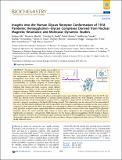| dc.contributor.author | Elli, Stefano | |
| dc.contributor.author | Macchi, Eleonora | |
| dc.contributor.author | Rudd, Timothy R. | |
| dc.contributor.author | Raman, Rahul | |
| dc.contributor.author | Sassaki, Guillherme | |
| dc.contributor.author | Viswanathan, Karthik | |
| dc.contributor.author | Yates, Edwin A. | |
| dc.contributor.author | Naggi, Annamaria | |
| dc.contributor.author | Torri, Giangiacomo | |
| dc.contributor.author | Sasisekharan, Ram | |
| dc.contributor.author | Guerrini, Marco | |
| dc.contributor.author | Shriver, Zachary H. | |
| dc.date.accessioned | 2015-06-19T19:02:50Z | |
| dc.date.available | 2015-06-19T19:02:50Z | |
| dc.date.issued | 2014-05 | |
| dc.date.submitted | 2014-05 | |
| dc.identifier.issn | 0006-2960 | |
| dc.identifier.issn | 1520-4995 | |
| dc.identifier.uri | http://hdl.handle.net/1721.1/97481 | |
| dc.description.abstract | The glycan receptor binding and specificity of influenza A viral hemagglutinin (HA) are critical for virus infection and transmission in humans. However, ambiguities in the interpretation of the receptor binding specificity of hemagglutinin from human- and avian-adapted viruses have prevented an understanding of its relationship with aerosol transmissibility, an exclusive property of human-adapted viruses. A previous conformational study, which we performed, indicated that human and avian receptors sample distinct conformations in solution. On the basis of detailed nuclear magnetic resonance (NMR) studies provided herein, we offer evidence of the distinct structural constraints imposed by hemagglutinin receptor binding sites on the glycan conformational space upon binding. The hemagglutinin from the SC18 virus, which has efficient aerosol transmissibility in humans (human-adapted), imposed the most stringent constraints on the conformational space of the human glycan receptor (LSTc), compared to single (NY18) or double (AV18) amino acid HA mutants, a property correlating to the ligand–HA binding strength. This relationship was also observed for the avian-adapted HA, where the high affinity binding partner, AV18, imposed the most stringent conformational constraints on the avian receptor, compared to those imposed by NY18. In particular, it is interesting to observe how different HAs when binding to human or avian glycosidic receptors impose significantly different conformational states, in terms of the states sampled by the glycosidic backbone and/or the entire molecule shape (linear or bent), when compared to the corresponding unbound glycans. Significantly, we delineate a “characteristic NMR signature” for the human adapted hemagglutinin (SC18) binding to human glycan receptors. Therefore, the conformational space constraints imposed by the hemagglutinin receptor binding site provide a characteristic signature that could be a useful tool for the surveillance of human adaptation of other (such as H7N9 and H5N1) deadly influenza viruses. | en_US |
| dc.description.sponsorship | National Institutes of Health (U.S.) (Grant R37 GM057073-13) | en_US |
| dc.description.sponsorship | Singapore-MIT Alliance for Research and Technology | en_US |
| dc.language.iso | en_US | |
| dc.publisher | American Chemical Society (ACS) | en_US |
| dc.relation.isversionof | http://dx.doi.org/10.1021/bi500338r | en_US |
| dc.rights | Article is made available in accordance with the publisher's policy and may be subject to US copyright law. Please refer to the publisher's site for terms of use. | en_US |
| dc.source | American Chemical Society | en_US |
| dc.title | Insights into the Human Glycan Receptor Conformation of 1918 Pandemic Hemagglutinin–Glycan Complexes Derived from Nuclear Magnetic Resonance and Molecular Dynamics Studies | en_US |
| dc.type | Article | en_US |
| dc.identifier.citation | Elli, Stefano, Eleonora Macchi, Timothy R. Rudd, Rahul Raman, Guillherme Sassaki, Karthik Viswanathan, Edwin A. Yates, et al. “Insights into the Human Glycan Receptor Conformation of 1918 Pandemic Hemagglutinin–Glycan Complexes Derived from Nuclear Magnetic Resonance and Molecular Dynamics Studies.” Biochemistry 53, no. 25 (July 2014): 4122–4135. © 2014 American Chemical Society | en_US |
| dc.contributor.department | Massachusetts Institute of Technology. Department of Biological Engineering | en_US |
| dc.contributor.department | Massachusetts Institute of Technology. School of Engineering | en_US |
| dc.contributor.department | Koch Institute for Integrative Cancer Research at MIT | en_US |
| dc.contributor.mitauthor | Raman, Rahul | en_US |
| dc.contributor.mitauthor | Viswanathan, Karthik | en_US |
| dc.contributor.mitauthor | Shriver, Zachary H. | en_US |
| dc.contributor.mitauthor | Sasisekharan, Ram | en_US |
| dc.relation.journal | Biochemistry | en_US |
| dc.eprint.version | Final published version | en_US |
| dc.type.uri | http://purl.org/eprint/type/JournalArticle | en_US |
| eprint.status | http://purl.org/eprint/status/PeerReviewed | en_US |
| dspace.orderedauthors | Elli, Stefano; Macchi, Eleonora; Rudd, Timothy R.; Raman, Rahul; Sassaki, Guillherme; Viswanathan, Karthik; Yates, Edwin A.; Shriver, Zachary; Naggi, Annamaria; Torri, Giangiacomo; Sasisekharan, Ram; Guerrini, Marco | en_US |
| dc.identifier.orcid | https://orcid.org/0000-0002-1288-9965 | |
| dc.identifier.orcid | https://orcid.org/0000-0001-9344-0205 | |
| dc.identifier.orcid | https://orcid.org/0000-0002-2085-7840 | |
| mit.license | PUBLISHER_POLICY | en_US |
| mit.metadata.status | Complete | |
